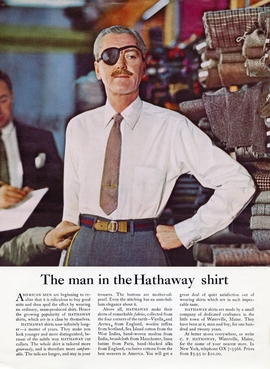George Wrangell
From Wikipedia, the free encyclopedia
Baron George Wrangell (September 1, 1903, Russian Empire - June 8, 1969, New York City) was a Russian-American advertising model, noted as originating the role of "The Man in the Hathaway Shirt" in a long-running advertising campaign, one of America's most recognizable.[1]
Baron George Wrangell | |
|---|---|
 Wrangell's first appearance as The Man in the Hathaway Shirt, 1951 | |
| Born | September 1, 1903 |
| Died | June 8, 1969 New York City, US |
| Occupation | Advertising model |
| Family | Wrangel family |
Family
Wrangell was a Baltic German baron, a member of the noble Wrangel family, and a White Russian émigré after the fall of the Russian Empire. His parents were general Baron Nikolai Alexandrovitch Von Wrangel of Terpelitzy and Maria Vladmirovna. From 1916 his step mother Baroness Elizabeth Hoyningen-Huene. He was the nephew of Pyotr Wrangel, last commander of the white forces in the Russian south. He had two brothers, Vladimir and Nikolaus. He had three sisters, Maria,Vera, and Xenia.[2][3]
Life
Summarize
Perspective
Wrangle settled in New York, where he served as a society columnist for the New York Journal-American.[4]
Wrangle's "Man in the Hathway Shirt" character, who always sported an eyepatch, was created in 1951 by David Oglivy.[2] Ogilvy explained that the eyepatch was intended to turn the image from an ordinary product photo shoot into a story, leading readers to wonder who the man was and how he lost an eye,[5] drawing the reader into the rest of the story:[6] the typical Oglivy extensive ad copy. Oglivy, inspired by a photo of Ambassador Lewis Douglas,[2][7] by serendipitous chance saw a pirate costume eyepatch in a store on the way to the first shoot, and elected to have Wrangell wear it for the ad.[8][9] (Wrangell himself had full vision in both eyes.)
The eyepatch – never explained – gave Wrangell's character an air of mystery, allure, and intrigue. Wrangell's character – a worldly, distinguished-looking gentleman – displayed an aristocratic aura, and was shown in settings typical of a debonair man of leisure: composing music, playing chess, drinking wine, stepping off a plane, playing the cello, sailing, fencing, buying a Renoir, and so forth.[1][5][10][6][9][11]
The campaign debuted in the September 22, 1951, issue[7] of the literary, upmarket The New Yorker[9] and ran into the 1980s.[1] Wrangell himself retired in 1961, and was replaced by other models.
The campaign was very successful, boosting the Hathaway shirt company's profile and sales to a considerable degree (sales increased more than 65% over the next four years)[12] and influenced the future direction of the advertising industry itself and made Oglivy's reputation.[12][5][10][8]
Death
See also
- Commander Whitehead, a similarly debonair advertising character
- The Most Interesting Man in the World, a similarly debonair advertising character
References
Wikiwand - on
Seamless Wikipedia browsing. On steroids.
